Blog:
Engagement is not a spectator sport: Value of Local TV Report 2

Each JA forum comes to life through a community outreach campaign. In this post, we show how we do this engagement work. We hope you might be able to mulch some of this back into your own work – that this behind-the-scenes view inspires your own ideas on how to deepen your community relationships.
First, we try to anticipate how to enrich your experience, both as we invite you to participate and during the forum. We’re going to show you our “stack” in this post. That’s a little bit of tech speak – and more simple than sexy. The stack, as we refer to it, means getting the right combination of people and software that enables community idea exchange and collaboration.
This is our second report analyzing the JA’s recent forum on the value of local TV news. Last week we covered our preparation – “why” we put on that particular conversation– and our performance. This report offers the “how” – our methodology to deliver online engagement. The final report will explore a set of tangible artifacts, or “what” we’ve distilled from the conversation, a look to what’s next.
Interaction is built into the JA’s DNA
The JA is here to help enable and accelerate collaboration, innovation, learning and idea sharing. It’s hard to engage if you can’t interact. So interaction is central to the JA’s ability to be of service. Our holy grail is to deconstruct and map out methods of engagement. Our mission is inspired by these questions:
How can we bridge commonly held, critically important questions in journalism today? How can we better identify multiple streams of innovation responding to similar challenges? How can we help to make small ideas bigger and big problems smaller?
Host & Collaborate: Community Experience
How the forum on the Value of Local TV played out has a whole lot to do with how the community experience has been baked into the JA’s DNA.

As JA editorial director Emily Harris noted in our last post, these are “stats that would make any start-up happy.” But it doesn’t happen by chance. These results were a direct reflection of a “stack” of outreach tactics served up by the JA team in advance, in sequence, and while the forum was underway, with the constant aim of building a dynamic conversation across local broadcast TV news practitioners, academics, policy folk, advocates, public media and new media publishers.
The platform combines technology and people as an integrated system to support your ability to achieve your goals simply:
- Technology is layered to anticipate and surface things that will be useful to you.
- The technology system driving forum development and iteration (the “stack” you create to meet your mission and goals) is replicable.
- Forums and resource listings use ongoing, active campaigns to showcase emerging. innovation, these content layers are designed as search friendly and semantically wired.
- Outreach is driven by a team of real people who care for, get to know and tend to the JA community to help source, matchmake and report what we learn together.
- All interaction across the site, in the comment streams and in our outreach, is captured and tracked so we don’t waste your time. And we are easily able to pick up wherever we last left off with you.
- Measurement is equal parts hard data and anecdotal findings, with social listening and synthesis of metrics to help us better understand where and how the JA is useful to you.
Here are the details – how that all happens.
Platform & Technology
For our forum asking the community how they see The Value of Local TV News, our goals for the community experience required:
- A structure that enables participants to volley in a rapid fire conversation, that doesn’t get in the way while supporting news practitioners and diverse expertise streams.
- The ability to reach across silos; industries and disciplines within the field (e.g. online and offline publishers, academics, TV newsrooms , policy experts, advocates, producers, etc.)
- An outline of issues to identify a representative participant mix that would yield diverse perspectives and capture a snapshot of this transitional time for local TV news.
- Transparency; the ability for participants to be able to see each other, and quickly assess who they are talking with.
In the for-profit world, blending technological and customer support systems is known as “CRM” or a customer relationship management system Rusty Coats, technology consultant for The Patterson Foundation, assessed the JA’s technology framework and found the community support systems were designed to “make sure that nothing is wasted.”
Rusty found the JA “stack” particularly interesting “not because of its specific parts – but what it does. It listens.”
Here’s how he explains it:
The Journalism Accelerator is a souped-up assembly of open-source and proprietary software. Think of it as a Lego stack. Each block interlocks with the other.
In simple terms, here is the JA architecture:
The site’s public face is WordPress. This open-source platform is a popular blog software ideal for interactive publishing….
One layer down is the BuddyPress plugin, which handles user registration, tags users to self-selected interests and ties in social media channels such as Twitter. This creates profiles so users can interact more meaningfully – finding others by shared interests, what they’ve commented on, what they’ve said on Twitter, etc. This also recognizes that use of the site doesn’t occur in a vacuum; users are active in conversations off-site, and the JA harvests that.
Beneath BuddyPress is Highrise a CRM (customer relationship management) tool that [tracks] user behavior and enriches the BuddyPress profile…
Beneath Highrise is Radian6 – sentiment-analysis software that listens to online conversations – on the JA and elsewhere – and algorithmically determines the “mood” and drivers of those conversations…
Put it together and you have a site that looks like a blog but is actually a learning ecosystem….
We recently added JanRain to the stack. This allows automatic authentication and simplifies your ability to interact with the community and on the site. Authentication brushes privacy, so we’ve crafted a post explaining how it works, and the criteria we used to determine its value to the JA community.
Outreach: By the People and for the People
Timing & Layers: Actively reach out

Emily Harris and Tricia Waineo work through the punch list preparing for the forum. Photo by Lisa Skube.
We researched our outreach plan for the TV forum by tracking online conversations already happening around the issue and talking with people working in the field. This also helped map out the perspectives we thought would yield a robust conversation.
Outreach to invite participants to the Value of Local TV News online forum was built in three waves.
A combination of twitter, email, phone calls, chats, hashtags and blog comment threads provided an immediate reach (in late October) to approximately 700 JA twitter followers, 2,300 site visitors, and over 100 participant candidates we’d built into our direct outreach campaign. We shared an email, a direct message on twitter, a phone call or a combination of these things with potential participants.
Waves of outreach were layered in context and over time to connect with a mix of people beyond the usual suspects. This allowed us to identify issues, structure the conversation around points of participant expertise or curiosity, and in many cases, make a personal connection.
Social outreach
We layered messages via twitter and linked in groups, to generate early buzz about the forum. During this first wave for the local TV news forum, we vetted feedback and conducted additional research. This process helped inform the panelist composition with unique expertise and perspective. New and old school outreach combined in a give-and-take approach, like good crop rotation.
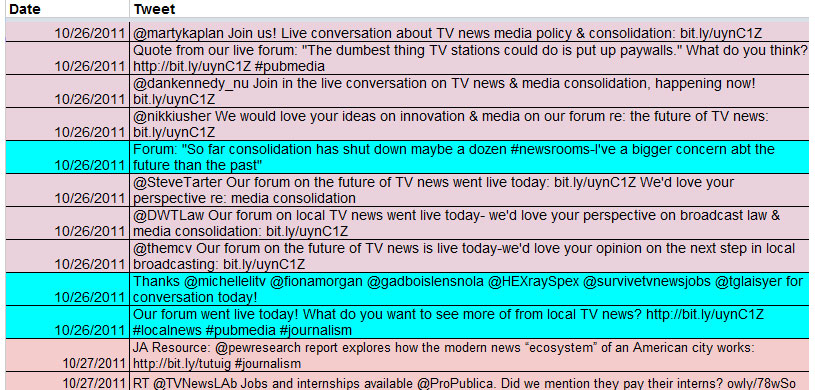
Twitter was a central element of our forum outreach strategy. Here's a behind-the-scenes look at how the JA team runs forum campaign outreach.
Tactics
- Share love (twitter, follow on twitter, DM, RT) with the folks helping inform, or inspiring, the forum.
- Reach out directly by phone, email and direct messages on twitter.
- Honor people’s time we reach out to by knowing their work in advance.
- Keep conversations brief with goals clearly outlined.
- Convey concrete benefit participants gain, the JA profile a showcase of the work you’re doing, to other publishers/innovators/journalism doers.
- Participate in other’s chats and online conversations to learn how the issue intersects across communities.
- Follow through.
Deepening connections through JA Community Profiles
Creating a simple way for news practitioners and new media news producers to connect and showcase your content products, projects, innovations and experiments is a vital part of the JA’s circulatory system. Profiles are integrated across resource listings, comments in forums, tweet streams, web sites or project sites. The JA is built for traction; the bots dig our vibe as we pay close attention to algorithms evolution and iteration.
In the Value of Local TV News forum, our goal was to help community members know who they were talking to. Basic profiles provided a quick identify. When participants filled out their full profiles, others could easily glean areas of expertise and the experience of participants. Ultimately, this knowledge helps all parties broaden their networks.
Tactics:
- Simplify the ability for community members to participate and contribute.
- Build community into every layer of the project, to showcase work and thinking.
- Ensure those who are a part of the community share who they are professionally, including the option to offer areas of expertise.
- Offer our community an authentication system that best protects your security and identity.
- Be transparent about what kind of information you capture and why. Let people know how their data is aggregated.
Content & Package
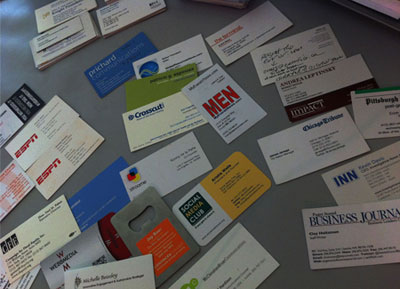
Blending old and new school tactics, following through with the smart people we meet is a core part of the JA's customer service model. Photo by Lisa Skube.
A crucial part of community engagement is getting potential participants involved in the early process of a forum. So we create content on the site to let people know a forum is in development. This includes resources related to the forum topic and background on the blog.
In the local TV news forum, a couple of the interviews laid out different perspectives on the blog, posted the day the forum launched. And the week before launch, we posted a preview on the blog to prime the community about the conversation in development.
Tactics:
- Involve knowledgeable people and network leaders in the design of the conversation.
- Provide additional context to add value for people who drop by.
- Leverage the wisdom and work of others to offer context in a package to present a holistic view of a range of perspectives on the question being addressed.
- Mulch the learnings and resources back into the JA.
“Care and feeding”
As the conversation goes live, we tend the fire to keep the community engaged. Tactics during the forum on local TV included:
- Kicking off the conversation in a specific time slot so people could book it.
- Participating in other innovators’ and publishers’ conversations while the forum was underway, joining the conversations others were exploring that intersected with the forum focus.
- Building a cultural framework through curation that encourages open, honest and respectful conversation.
- Keeping the conversation thread open. We pursue questions with a shelf life, and our authentication process protects participants and the site from spam assaults.
Methodology: Iterate and optimize
Historically comment threads often “talk at things” but do little to really advance the game collectively. Working with a blog platform presents all kinds of challenges to facilitate substantive or complex conversations that can branch into a number of directions.
We’re refining a number of things before the next forum, which kicks off on December 7, 2011. This conversation will explore ideas to create deeper publisher collaboration and take advantage of tools available to help cover the 2012 elections.
We’re experimenting with a range of improvements. For example, we’re exploring development of the ability to post to the comment thread via email, again using technology to simplify community participation. We’re integrating content you see to the side of the forum thread to more closely relate to the conversation, highlighting recent comments, tweets, and relevant resources. And we’re making it easier to get to know the people you’re talking with, by creating a page to see all participants at a glance, sort the conversation by people, and show additional expertise as participants provide it.
Research, experimentation, deep thinking and intention guides and informs the evolving design of the JA community user experience. Your ongoing feedback helps us direct the priorities around how the JA continues to improve as an online community gathering place. We’ll continue to report what we learn in the hopes you can apply the insights to your own work. Weigh in with questions, things you’d like to see on the site, or more behind-the-scenes happenings you’d like to know about.


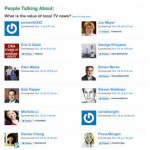
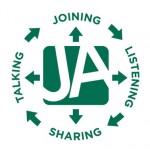
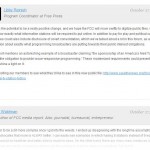
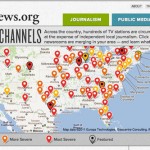








Weigh In: Remember to refresh often to see latest comments!
3 comments so far.
-
 Ikaika Hussey says:
Ikaika Hussey says:
January 5, 2012 at 2:38 am
-
 Jeff Lennan says:
Jeff Lennan says:
January 5, 2012 at 11:43 am
-
 Joy Mayer says:
Joy Mayer says:
December 7, 2011 at 1:33 pm
| ParticipantsGreat post. Interested in the posting-comments-via-email piece. Is there a product on the market that does this, or is this being done in-house?
Hi Ikaika. Thanks for the note. Reply via email is something we have seen be very effective in other applications – like Basecamp by 37 Signals and we are looking into using it on this site. To what extent we have to write this, or modify existing code in the WordPress commenting structure, we don’t yet know. We appreciate your interest and will keep you posted. Any input you have would also be great.
Thanks for the transparency, guys! It’s a great model to follow.